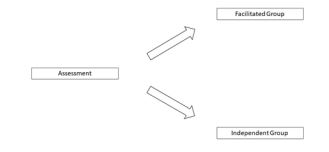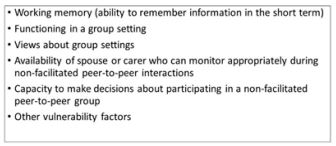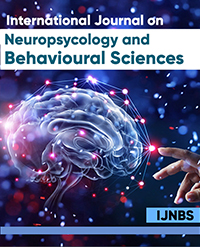The Digital Dementia Neighbourhood: Addressing Social Isolation in People with Dementia in the Digital Age with a Two-Group Model
Simon McVay1, Dr. Alican Bulut1, Maria Blanche3, Dr. Adedamola Adeyanju1, Sioux Worsfold1, Dr. Justin Marley1
1Essex Partnership University NHS Foundation Trust (EPUT), United Kingdom
2Dementia Partnership Delivery Lead, Essex County Council, United Kingdom
*Corresponding author: Alican Bulut, Kingswood Centre, Turner Road, Colchester, Essex, CO4 5JY, United Kingdom
Article History
Received: January 29, 2022 Accepted: March 02, 2022 Published: March 04, 2022
Citation: McVay S, Bulut A, Blanche M, et al. The Digital Dementia Neighbourhood: Addressing Social Isolation in People with Dementia in the Digital Age with a Two-Group Model. Int J Neuropsy Beh Sci. 2022;3(1):14‒16. DOI: 10.51626/ijnbs.2022.03.00025
Abstract
The older adult population is increasing as is the population with cognitive impairment and Dementia. Loneliness and social isolation can have a significant impact on these populations. There is an opportunity to address these problems using digital solutions. Recent developments in the use of technology in the Covid-19 pandemic has resulted in improved ways of connecting people digitally. We propose the Digital Dementia Neighbourhood featuring a two-group model to assess suitability for connecting people with Dementia virtually both with and without facilitators. The two-group model enables a maximisation of telehealth opportunities, promoting access to connected and stimulating activity. The Digital Dementia Neighbourhood can be expanded to support care and well-being virtually.
Keywords: Dementia; Technology with dementia; Social isolation; Dementia support
Background
Dementia is defined as an irreversible progressive clinical syndrome in which cognitive deterioration results from an underlying brain disorder [1]. There are many different causes and types of Dementia. Types of Dementia include Alzheimer’s type, vascular, frontotemporal and Lewy-body dementia.
The prevalence of dementia is 1 in 14 of the population aged 65 years and over. The number of people with dementia in the UK is forecast to be over 1 million by 2025 [2]. Alzheimer’s-type dementia accounts for 60- 80% of individuals presenting with late-onset dementia [3]. Other common causes of late-onset dementia include Lewy-body dementias [4] and vascular dementia. 6-9% of dementias are of young-onset [5]. Alzheimer’s-Type dementia accounts for up to 38.8% of young-onset dementia cases [6].
Management of dementia includes both medication and non-medication approaches. The medication approach includes cognitive enhancers to slow decline in Alzheimer’s-type dementia [7] and medication to address comorbid conditions such as depression or psychosis. Non-medication approaches can help alleviate suffering in people with dementia. Non-medication approaches including physical exercise and social activities can considerably improve the quality of life [7].
The world is becoming better connected digitally. With the Covid-19 pandemic there has been a rapid adoption of relevant technologies particularly for helping people to connect. People with Dementia who are socially isolated could benefit from better connecting with technology. Prolonged social isolation is a risk factor for delirium, agitation, and apathy in this population. The Covid-19 pandemic has increased the risk of social isolation and there is evidence of worsening neuropsychiatric symptoms among the older adult population [8]. In 2014, Essex County Council (ECC) published the ‘Who Will Care’ report that identified a number of high-impact solutions that are aligned with community objectives. One objective was to use of data and technology to the benefit of the people of Essex. This ‘digital first approach’ can be used to enable people to ‘live well with dementia’ [9]. We propose a model in which people with Dementia connect virtually.
The Two-Group Model
We propose a two-group model (Figure 1) that can be supported by specialist Dementia services. The model is simple enough to be adopted by organisations across the health and social care economy.
Figure 1: The Two Group Model.
In the assessment stage there is an assessment by trained facilitators. The person with Dementia is assessed in a group setting by the facilitators. The assessment identifies how the person will function both by themselves and with their available support. A conclusion is also reached on how the person will function in a group without a facilitator. There are many factors that will influence a person’s functioning in the virtual group setting (Table 1).
Table 1: Factors Evaluated in Assessment for Suitability for Non-Facilitated Peer-to-Peer Support.
The facilitated group will be safe, easy-to-use as well as independent of the technology (i.e. works with different technologies). As an example, people who have met each other in a Cognitive Stimulation Therapy group can share their journey together, and can meet in a virtual room and have tea together. This basic model can be expanded with the support of focus groups and could for example use recorded resources.
Discussion
Digital technology skills are fast becoming part of the skill set needed for daily living, whether to pay bills, maintain social relationships, book appointments or access social and leisure opportunities. There is also evidence that digital technologies can reduce the social isolation of older adults by connecting them with the outside world, gaining social support, engaging in activities of interest, and boosting self-confidence [10]. Many older adults are enthusiastic, competent and confident users of digital technology [11].
An increasing number of people with dementia have digital technology skills, and should be supported to maintain these skills for as long as possible. The barriers to people with dementia being able to maintain these skills likely include technology complexity as well as age and condition-related capability changes. Therefore people with dementia using digital technology will need support to overcome these challenges. They will also need to be motivated to engage with the technology. By matching the demands of the technology to individual capabilities, the person’s abilities can be optimised. This in turn can contribute towards an inclusive, dementia-friendly society [12].
Staff in our service have experience of delivering virtual cognitive stimulation therapy (CST) during the Covid-19 pandemic. There have been of a number of people with dementia reporting increased confidence using digital technology as a result of having participated in an online group, where staff have been on hand to support participants to resolve technical and accessibility problems. Participants have reported that this increased confidence has generalised to their use of this technology outside the CST group sessions, to make and maintain contact with friends and family.
We propose a digital neighbourhood model that builds on the sense of community developed during cognitive stimulation therapy groups for people newly diagnosed with dementia. These people are usually in the earlier stage of the condition when coping strategies can be put in place to maintain quality of life for as long as possible.
In considering a local adaptation of the two-group model, we propose that the model can be piloted in people with dementia who have met in our CST group, to continue to connect with each other by forming a ‘digital neighbourhood’. Participants in our CST groups often comment that one of the most valuable aspects of the experience is being with others who are going through a similar life challenge.
The proposed videoconferencing facility would be developed with guidance from people with dementia themselves, and be designed to be easily navigable and user friendly for people who have a cognitive impairment. Users would become familiar with the facility while still in the early stages of their condition, perhaps as part of their involvement in the CST group, and then continue to use it for as long as possible, with support from a care partner where necessary. The facility could have meeting rooms where users can go to have a virtual coffee morning, or where real time group activities can take place. There could also be video recordings of activities available for users to engage in at any convenient time. Facilitators would ensure that this remains a safe environment, with potential users being assessed for their capability to engage with this peer-to-peer network independently, or whether they require a degree of support.
Conclusion
The Digital Dementia Neighbourhood is a solution to help people with Dementia connect with each other. The Covid-19 pandemic has shaped the use of technologies which help people better connect. Our model of a Digital Dementia Neighbourhood is timely and incorporates technology solutions that have become more socially acceptable.
Conflicts of Interest
The authors report no conflicts of interest in this work.
Funding
This research did not receive any specific grant from funding agencies in the public, commercial, or not-for-profit sectors.
References
- https://icd.who.int/browse10/2016/en#!/F00-F09
- https://www.alzheimers.org.uk/sites/default/files/migrate/downloads/dementia_uk_update.pdf
- Alzheimer’s Association (2015) Alzheimer’s disease facts and figures. Alzheimers Dement 11(3): 332-384
- Zuzana Walker, Katherine L Possin, Bradley F Boeve, Dag Aarsland (2017) Lewy Body Dementias. Focus 15(1): 85-100.
- Stevie Hendriks, Kirsten Peetoom, Frans RJ Verhey, Marjolein de Vugt, Sebastian Koehler (2020) The prevalence of young onset dementia: A systematic review and meta-analysis. Journal of the Alzheimer’s association 16(S10): e042738.
- Bhargavi Devineni, Chiadi U Onyike (2015) Young-onset dementia epidemiology applied to neuropsychiatry practice. Psychiatr Clin North Am 38(2): 233-248.
- Arvanitakis Z, Shah RC, Bennett DA (2019) Diagnosis and Management of Dementia: Review. JAMA 322(16): 1589-1599.
- Manca R, De Marco M, Venneri A (2020) The Impact of COVID-19 Infection and Enforced Prolonged Social Isolation on Neuropsychiatric Symptoms in Older Adults With and Without Dementia: A Review. Front Psychiatry 11: 585540.
- Who Will Care (2014) Essex County Council.
- Chen Y, Schulz P (2016) The effect of information communication technology interventions on reducing social isolation in the elderly: A systematic review. J Med Internet Res 18(1): e18.
- Damodaran L, Olphert CW, Sandhu J (2014) Exploring the Challenges to Sustained Digital Engagement by Older People. Gerontology Regenerative and Technological Section 60: 163-173
- Wallcook S, Nygård L, Kottorp A, M Camilla (2019) The use of everyday information communication technologies in the lives of older adults living with and without dementia in Sweden. Assistive Technology 33(6): 333-340.



